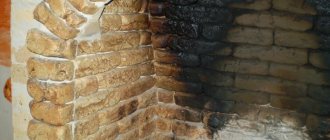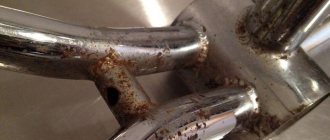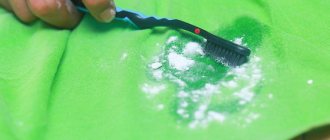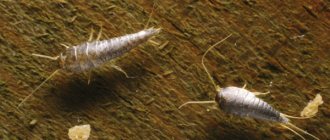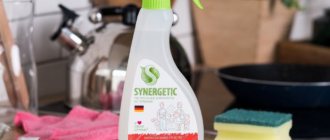One of the most problematic places in the kitchen is the stove. It can be gas, electric or induction, but all require careful care, regardless of brand or type. During the cooking process, splashes of boiling fat, broth, and various liquids fall on the cooking surface and sides, and pieces of solid food become stuck. From time to time, milk or porridge floats onto the stove due to incorrectly selected temperature conditions or ordinary absent-mindedness. The result is usually not pleasing, because all this has to be thoroughly cleaned.
Unlike the inner walls of an oven or microwave, which are covered with glass, the stove is always visible. And its untidy appearance can ruin the entire impression of a well-groomed, beautiful kitchen set. In addition, burnt organic matter emits an unpleasant odor and, over time, turns into black scale that firmly adheres to the parts of the stove. Therefore, cleaning should be done when soiled, following fresh traces. How to do this as quickly as possible and without expensive purchases? Let's listen to the advice of experienced experts.
Tools that are always at hand
Any person who has experience cooking on a stove and then cleaning it knows: it is better to remove dirt immediately before it sticks to the metal or glass from the heat. With modern hobs, which are a solid glass-ceramic surface without cracks or additional parts, it’s easier: just wash them with a mild detergent and wipe dry. The touch control panel is also easy to use. But with a gas stove or electric stove with burners you will have to tinker, scrubbing all the structural elements, cracks and gaps. That is why it is so important to choose the right product that will make your work easier and will quickly remove all stains and deposits.
There are several general safety rules that should be followed when starting cleaning:
- to protect the skin of the hands, use household gloves;
- You should carefully handle caustic substances and solutions - acids, soda, vinegar, and follow the instructions for use;
- during general cleaning, which affects all elements of the stove, it is necessary to turn off the power and shut off gas access;
- For cleaning, sponges, special microfiber cloths, and smooth cotton fabrics are used;
- On a gas stove, first remove the grates, then the burners and valves. Install after cleaning in reverse order;
- Gas stove burners require special attention. All openings through which the flame escapes must be clean, without burnt crust. To clean them, you will need a needle or thin awl, an unbent paper clip, or a pin;
- Before applying the cleaning agent, sweep away dry crumbs with a soft brush or dry cloth.
Cleaners with abrasive particles, as well as the abrasive side of sponges, are not recommended: they can leave scratches even on hardened steel, not to mention glass or enamel.
Preparing for cleaning
If a global cleaning of the hob is planned, you must first:
- Turn off the power source. If it is gas, then close all valves. For an electric stove, simply remove the plug from the socket.
- Remove small parts that should also be cleaned.
- Remove nearby objects that will only get in the way during the cleaning process.
Expert opinion
Galina Valerievna Borodina
To prevent heavy grease stains on the stove, it is recommended to wipe its surface after each cooking process. In industrial environments, special foil protection is used, which prevents grease and food debris from getting onto the hob.
Soda
Sodium bicarbonate is a real housewife's assistant in the kitchen. It perfectly degreases, eats away dirt no worse than patented products, and brings shine and beauty. At the same time, soda is delicate enough not to spoil induction hobs, enamel and individual structural parts.
- Ordinary powder is diluted with a small amount of water to a paste and applied to dirty areas, left for half an hour. You can lightly rub the surface with this mixture, but be very careful not to leave microscopic scratches. Then the pulp must be removed with a dampened cloth, wiped clean and dry. In addition to the hob, handles and electric stove burners are treated in the same way. If the handles are not removable, for convenience, use small brushes with long handles - dental or specialized. In addition, soda gruel cleans smoked gas stove grates well. To do this, leave the product for 2-3 hours, and rinse it off under the tap, rubbing vigorously with the hard side of the sponge.
- Baking soda with vinegar is another effective remedy in the fight to keep the stove clean. First, 6-9% vinegar is applied to the contaminated surface, then covered with soda. The resulting reaction effectively removes all unsightly stains. After this, just remove the foam and wipe dry.
- Soda and soap remove grease and stubborn carbon deposits well. To do this, ordinary liquid soap is mixed with powder in a 1:1 ratio and applied to problem areas for ten to twenty minutes. Then all that remains is to wash off the slurry along with the dirt.
- To quickly clean old carbon deposits and stains, you will need 3 tbsp. l. soda ash, 100 ml washing powder, 1 tbsp. l. stationery silicate glue and 200 ml of water at room temperature. The mixture is applied to the stains, left for twenty to thirty minutes, and washed off.
How to effectively clean a gas oven
In many models of gas stoves, gas ovens have a collapsible design. The elements of the oven are removed and treated with detergents prepared according to a convenient recipe. A method for cleaning a non-separable oven can be to irrigate the external cavity with a home remedy - a solution of soda, water and vinegar. They need to generously spray the walls and top. Leave for half an hour. Then wash off.
The most popular way to quickly remove accumulated carbon deposits is to place a baking sheet with a soap-soda solution in an oven preheated to 120⁰C. Continue the procedure for an hour. Then wash the warm oven with a cloth.
Dishwashing liquid
Fresh stains can be easily removed with regular dish gel. To do this, pour a little soft product onto a damp sponge or napkin and foam. Then applied to the surface. If the dirt and grease have already dried, you need to leave the foam for 10-15 minutes. Then wipe everything off by pressing the sponge to the surface. Walk with a clean, dampened cloth several times and wipe the stove dry.
What to do if there is a dense layer of fat?
What products do you use to clean the stove?
FolkChemical
If we are talking about old fat deposits that have almost never been removed, before cleaning you should:
- Take a narrow spatula and, using light pressure, remove the fat, getting as close to the surface of the slab as possible.
- Using a wide brush, distribute boiling water evenly in particularly difficult areas, let stand for 20-30 minutes.
- When the grease coating becomes soft, repeat the procedure, but be very careful, as careless movements can scratch the slab.
If there is no opportunity or time to tinker, and the result is needed in the shortest possible time, you can use heavy artillery in the form of special equipment.
Grease remover "Unicum"
It is necessary to distribute the product over the surface of the stove, leave for a few minutes and rinse off with a damp sponge. The product is recommended to be used only for difficult stains, since it contains aggressive substances that can destroy the protective enamel with frequent cleaning.
Advantages:
- Has a convenient sprayer.
- Does not require additional effort in the form of friction.
- Residues are easily removed.
Flaws:
- Relatively high cost and fast consumption.
- Unpleasant pungent odor.
It can be used not only for the stove, but also for ovens, where greasy deposits are especially difficult to remove.
Mr Muscle kitchen expert
This product is suitable for all slab surfaces, as well as adjacent surfaces. Does not contain harmful and highly toxic substances.
Advantages:
- Sprays easily and quickly breaks down grease.
- Suitable for daily cleaning.
- The smell of freshness and cleanliness.
- Destroys bacteria (up to 99%).
Flaws:
- Relatively high cost.
The cleaning agent is sprayed onto the surface, allowed to soak in for 5-10 minutes, after which the remaining dirt is removed with a sponge.
Cillit Bang anti-fat
The product contains a complex formula that can remove greasy deposits and deposits not only on the stove, but also in the oven, microwave ovens, and baking dishes. Easy to apply to the surface, the foam does not spread.
Advantages:
- Reduces cleaning time.
- There is no unpleasant chemical smell.
- Leaves a glossy surface.
- Has a large bottle volume.
Flaws:
- Not identified.
Suitable for daily cleaning, easily copes with dirt. The product does not cause chemical burns upon contact with skin.
Cif anti-fat
An ideal product for everyday cleaning of the oven, but it will not cope with heavy fatty deposits.
Advantages:
- Easy to apply.
- Leaves a streak-free shine.
- Nice smell.
- Relatively low price.
Flaws:
- Small volume.
- Not suitable for marble and painted surfaces.
The composition of the product is gentle, but for safety you should use rubber gloves.
Laundry soap
For glass ceramics and enamels, a product based on ordinary brown laundry soap is excellent. Mix 2 tbsp. l. soda, 40 ml. vinegar and 1 tbsp. l. grated soap. You can add a little hot water to help the mixture dissolve better. The resulting slurry is left on the stove for 1-2 hours and washed off.
Stainless steel and enameled grates are immersed in a soap solution poured into a wide basin for ten hours, after which the soaked carbon deposits are well scrubbed off with a hard sponge. Removable verniers that are not too dirty can be soaked in a warm solution for twenty to thirty minutes, then wiped with the abrasive side of the sponge.
Results
All of the cleaning methods listed are suitable for both gas and any other stoves used in modern kitchens. Let us only add that for induction hobs, it is effective to use, in addition to the indicated folk remedies, ordinary vegetable oil ; it is perfect for caring for glass-ceramic products. A napkin soaked in oil should be held briefly on the stained area and then wiped with a soft sponge.
Once again, please note that the use of metal objects, including sponges, as well as powders and other abrasive materials when washing kitchen stoves can lead to scratches and other damage.
Lemon acid
Use fresh lemon, lemon juice or citric acid powder dissolved in a small amount of water. The acidic composition is left for twenty minutes and removed with a damp cloth. A bonus from using this product is a pleasant lemon aroma in the kitchen.
The best household chemicals for a gas stove
If you don’t want to bother with how to clean a stainless steel stove, then store shelves sell a lot of pastes and gels that carefully care for the surface and remove dirt.
Popular industrial products for cleaning a gas stove are:
- Frosch;
- Cif;
- Sano Multi Metal;
- Sun Clean Master;
- Ecover Cleaner;
- Milam Chemical and others.
The drugs are highly effective, but their use is not always affordable. Keeping them at home becomes more difficult if you have small children. Using them without gloves can injure the skin of your hands.
Ammonia
Ammonia does an excellent job of removing dried, old stains. 1 tsp. diluted in 200 ml of water and applied to the stove. After ten minutes, wipe the area with a sponge or soft brush. You can also use ammonia-anise drops. For stubborn stains, leave them for half an hour or sprinkle soda on top and gently wipe with a damp cloth.
Use a toothbrush or a cotton swab dipped in ammonia to clean the handles and burners. Removable parts are soaked in an aqueous solution in a 1:1 ratio.
In addition, ammonia allows you to tidy up the smoked grate of a gas stove. To do this, the solution is applied to all areas. The grille is folded into a thick plastic bag and sealed tightly for 3-6 hours, depending on the condition of the part. Then all that remains is to rinse under the tap with a sponge and dish gel - the carbon deposits flake off, leaving a perfectly clean surface.
Brushes, blades, scrapers, chemicals: use extremely carefully
Some slabs are prohibited from being treated with abrasive surfaces, which leads to the formation of scratches. Therefore, it is not recommended to use metal brushes, which can damage the protective coating. If you use an abrasive, let it be soft.
A synthetic bristle brush, the back of a dish sponge, or an old, used toothbrush will work. By the way, the latter helps to wash away old grease in the most difficult to reach places, including handles, burners and small parts.
As for chemicals that break down fat, they should be used very carefully:
- Firstly, if they are used frequently (more than once a week), there is a risk of damage to the surface layer of the slab.
- Secondly, it can only be used with personal protective equipment: rubber gloves, a respirator, and the room where cleaning is carried out must be well ventilated.
- Thirdly, chemical agents are not always effective against old fat deposits, which forces you to additionally use a brush. What's the point of spending money then?
Before you go to the store for advertised products that remove carbon deposits and grease from the stove in the blink of an eye, you should first try to cope with the contamination with what you always have on hand.
Method 4. Modification of the first method
A zip bag will also come in handy here, but in order to save budget, we will do without the use of expensive imported special equipment in the process. We will use ammonia. We dilute it with water and pour the resulting ready-made solution into the grate in the bag and leave it to soak.
Attention! Do not leave the bag with the lattice open, be sure to tie it tightly! Contact with air must be prohibited. Especially if there are small children at home.
After a few hours of exposure to the potion, you can take out the grate and wipe it with a dry cloth. By the way, you can also wash metal hood grates with ammonia in the same way, this will help remove fat accumulation.
Benefits, use in the kitchen
Sodium bicarbonate is a fine-crystalline, odorless, snow-white powder. It is difficult to list all the properties of this substance, since there are so many of them.
The most common schemes for using baking soda are as follows:
- getting rid of odor (sweat, food);
- relieving itching, antiseptic effect;
- removal of fluid from the body, elimination of heartburn;
- removal of age spots, freckles;
- baking powder for the dough;
- meat tenderizer;
- Cleaning agent for all surfaces except varnished and glossy.
The last point mainly concerns the use of soda for the bathroom and kitchen utensils: stove, microwave, oven, sink, hood, dirty dishes, etc.
The advantage of sodium bicarbonate is its cheapness, safety and absence of scratches on a smooth surface, since the solution can be prepared in such a way that the soda will not be an abrasive, but, on the contrary, will have a gentle effect on burnt fat.



